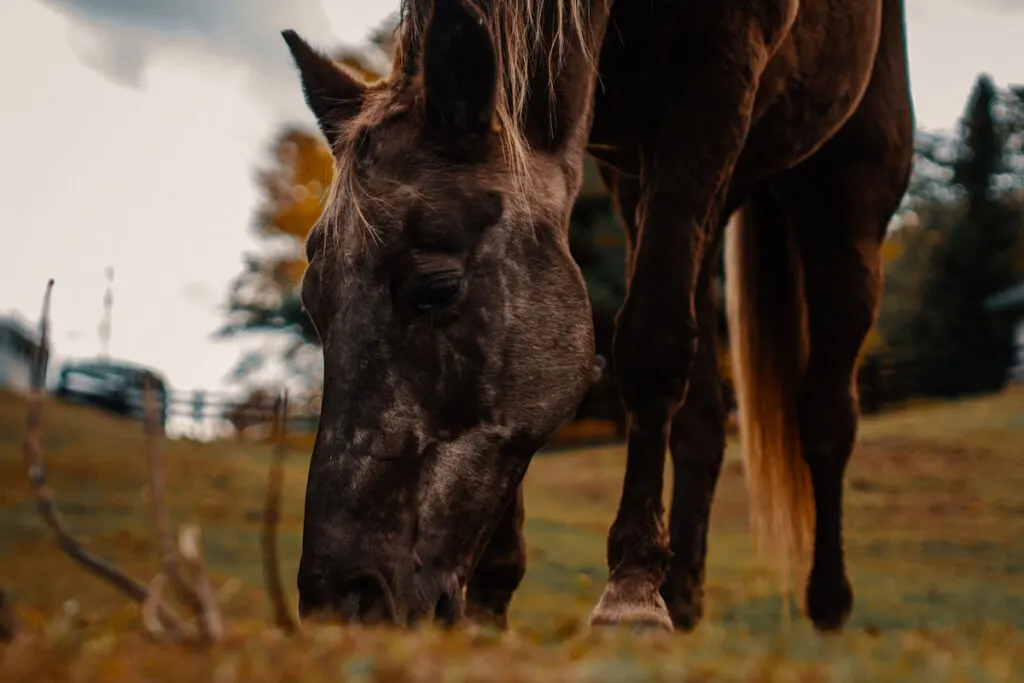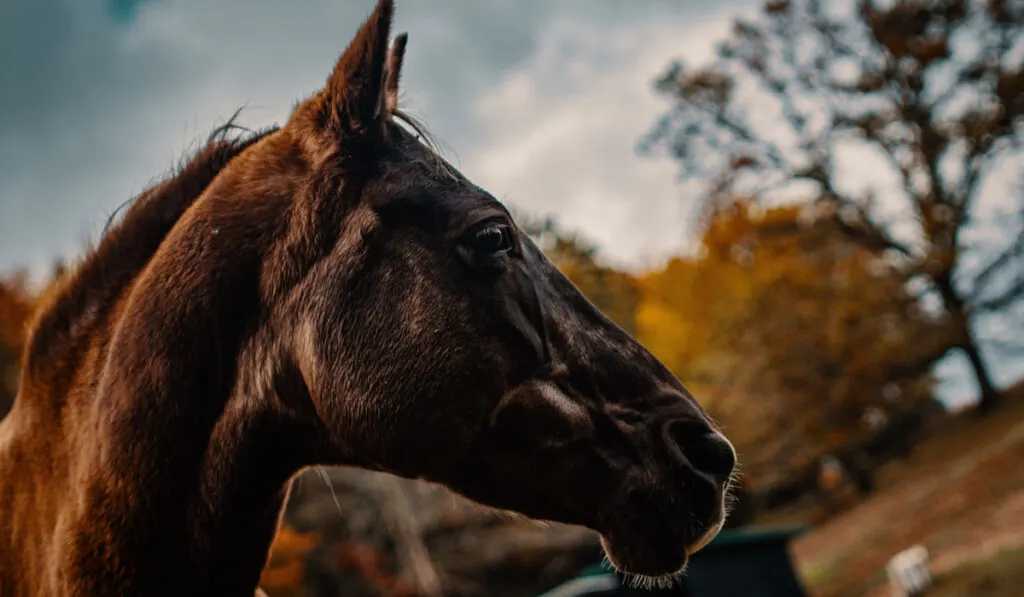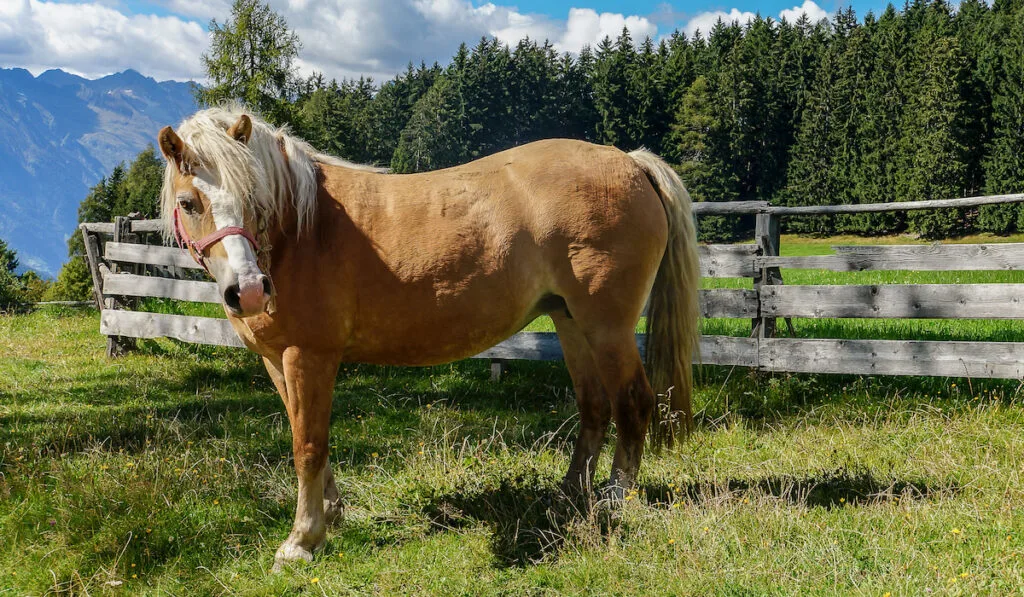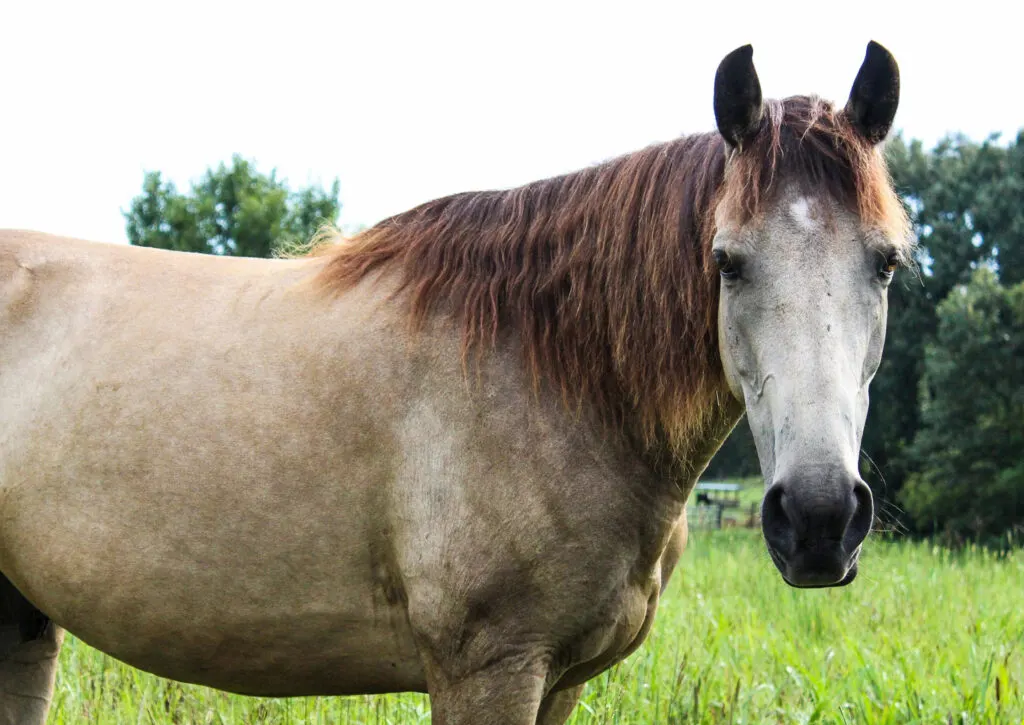The Mountain Pleasure horse is a smooth-gaited breed ideal for ranch labor, endurance, or trail riding.
Because of its calm demeanor and gorgeous appearance, it is also used in parades and other occasions.
Despite being a critically endangered breed, the Mountain Pleasure horse is one of the horses with an ambling gait. An ambling (four-beat) gait is usually non-taught, and horses with it naturally are comfortable to ride. It also enables the horse to stay energized even after covering a long distance. Because of this, people breed Mountain Pleasure horses for endurance.
To learn more about this special breed, we have compiled a detailed guide that explains all you need to know about Mountain Pleasure horses.

Table of Contents
Historical Background and Origin
Over 100 years ago, in the Appalachian Mountains of Eastern Kentucky, the Mountain Pleasure horse emerged as a crossbreed from earlier breeds in the region.
These breeds include the Rocky Mountain horse, the American Saddlebred, and the Tennessee Walking horse.
The goal of this crossbreeding was to create a horse that could withstand the rugged, rocky terrain while also providing a comfortable ride for the rider.
However, crossbreeding caused the horses to lose their purebred status, resulting in mountain or saddle horses.
Physical Characteristics
The Mountain Pleasure horse is a medium-sized horse standing between 14-15.2 hands high and weighing an average of 900 pounds.
The breed comes in various coat colors like black, sorrel, brown, and tan. The horse has a well-muscled body with a well-proportioned head.
And to ensure easy and comfortable riding, the Mountain Pleasure horse has the ideal shoulder lay back angle of 45°.
Temperament and Personality
Mountain Pleasure horses are kind, intelligent, and calm, making them a perfect choice for children and novice riders.
Furthermore, their intelligence and eagerness to learn make them easy to train.
However, these strong horses require a relaxed, clean, and airy environment where they can graze on good foliage and access clean water, just like in the serene mountain environment of their origination.
They also need regular exercise to maintain their well-muscled body.
Hence, do not confine your Mountain Pleasure horse to a barn with little exercise.
Registration of The Mountain Pleasure Horse
The Mountain Pleasure Horse Association (MPHA) and The Mountain Pleasure Horse Breeders & Exhibitors Association (MPHBEA) recognize the Mountain Pleasure horse breed.
However, there are specific breed standards the Mountain Pleasure horse must meet before registering with the MPHA and MPHBEA. These include breed, height, and gait.
For example, a Mountain Pleasure stallion must have a minimum of 14.2 hands, while geldings and mares must have 14.0.
In addition, the saddle horses must be DNA tested to ensure breed purity. They must also have a four-beat gait.
Famous Mountain Pleasure Horse
One of the most famous Mountain Pleasure horses was the Palomino-colored movie horse, Trigger.
Born in 1934, Trigger became famous because his owner was cowboy star, Roy Rogers. Trigger was 15.3 hands tall and could do over 100 tricks and walk 50 feet on his hind legs.
In 1965, Trigger died at 30 years old.
Despite his death, Apple Valley’s Roy Rogers and Dale Evans Museum preserved Trigger by stuffing and mounting him in their space.
When the museum closed in 2010, RFD-TV bought Trigger. He was later purchased by a developer who returned him to Apple Valley for display.
He also has his own Dell comic book recounting his adventures.

Lifespan
Since the Mountain Pleasure Horses can live up to 35 years, here are tips to help ensure your gaited horse lives longer. These include:
1. Provide a Clean and Suitable Environment
A clean, airy environment is essential for your horse’s health and well-being.
To accomplish this, ensure you do the following:
- Clean and disinfect the stall regularly. As horses spend most of their time in stalls, disinfecting ensures you prevent the spread of disease and parasites.
- Remove any soiled bedding and manure daily. Use high-quality bedding like straw and shavings to keep the stall clean and dry.
- Provide clean water. Also, clean and refill the water buckets or troughs daily to prevent the growth of bacteria.
- Room to roam. Ensure the Mountain Pleasure horses have sufficient space to move around and exercise.
2. Schedule Regular Veterinary Check-Ups
Mountain Pleasure horses require frequent veterinary examinations to avoid or detect potential health issues.
You should also work with the veterinarian to develop a regular health plan that caters to vaccinations, deworming, and dental care.
3. Practice Good Hoof Care
Proper hoof care is important because it improves performance and supports the horse’s bones, tendons, and ligaments.
It also reduces the likelihood of developing lameness. Lameness is a condition that limits the movement of a horse. Injury to the hooves causes lameness, resulting in limping and an uneven gait.
To cater to your Mountain Pleasure horse’s hooves, you should do the following:
- Clean the hooves regularly to remove debris, dirt, manure, and loose stones using a hoof pick or a brush.
- Trim the hooves every six to eight weeks to maintain proper length. Long hooves make it hard for a horse to walk, trot, canter, gallop, or side pass.
- Properly fit and maintain horseshoes. Ensure they are not tight or loose and replace them when worn out.
4. Develop a Balanced Feeding Plan
How your Mountain Pleasure horse feeds dramatically affects how long they live. Work with an equine nutritionist to develop a feeding plan to add more years to the horse’s lifespan.
The feeding plan should include the following:
- Consider the horse’s breed, weight, age, activity level, and health conditions.
- Feed the horses with the forage quality and type you can easily access or afford. But, ensure the forage is of high quality.
- Add high-quality concentrates like grains or pellets to provide additional nutrients the horse cannot get from forage. However, ensure the concentrate is appropriate for your horse’s age, activity level, and nutritional needs.
- Divide the feeding into multiple meals, as horses have small stomachs and should feed throughout the day. However, constantly monitor your horse’s body condition so as not to under- or overfeed the horse.
5. Provide Regular Exercise and Mental Stimulation
Mountain Pleasure horses’ breeding was for endurance, to trot and gallop through the treacherous trails of the mountains.
Mountain Pleasure Horses thrive on regular exercise and mental stimulation.
Therefore, provide them with stimulating activities like trail riding, arena work, learning tricks, and toy access. This will ensure an energized four-beat gaited horse.

Genetic Diseases
The most common genetic disease among the Mountain Pleasure horse is multiple congenital ocular anomalies (MCOA).
MCOA is an inherited eye disorder common in most mountain horse breeds. Ocular defects like cysts, enlarged cornea, and abnormally formed iris or retina are some of the signs of MCOA.
A Mountain Pleasure Horse with a silver dilution may have this disorder. Silver dilution lightens the manes and tails of black and bay horses to a blonde or silver-grey color.

The Mountain Pleasure Horse vs. Tennessee Walking Horse
The Tennessee Walking Horse is a four-beat gaited horse that is sometimes confused with Mountain Pleasure Horses. Here are some differences between these calm horses:
| Characteristic | Mountain Pleasure Horse | Tennessee Walking Horse |
| Origin | Eastern Kentucky | Tennessee |
| Height | 14–16 hands | 14.3–17 hands |
| Weight | 800–1100 pounds | 900–1200 pounds |
| Gait | Four-beat ambling gait | Four-beat running walk |
| Temperament | Calm and gentle | Calm and willing |
| Breed organizations | Mountain Pleasure Horse Association | Tennessee Walking Horse Breeders’ and Exhibitors’ Association |
Disciplines
The Mountain Pleasure horse, known for its smooth, easy gait built for endurance, is ideal for extended hours of trail riding.
Also, since the gaited breed has a gentle disposition, it is easy to train the Mountain Pleasure horse in dressage.
Dressage focuses on training horses in precise, controlled movements that they can perform in exhibitions and competitions.
Mountain Pleasure Horse Breed Criticism
Some horse breeders have found the Mountain Pleasure horse breed not pure, thus shying away from breeding with it.
In addition, meeting MPHA and MPHBEA requirements does not make rescuing the relatively low population of the Mountain Pleasure horse breed any easier.
However, Mountain Pleasure horses have many desirable qualities, like their calm and gentle temperament, which make them champions in some equestrian activities.
Conclusion
The Mountain Pleasure horse is a four-beat gaited breed that makes riding easier and more comfortable for even inexperienced riders.
Even though it has a relatively small population, its temperament, and ability to learn new tricks easily is enough for this equestrian. These traits make them ideal for pleasure and trail riding.
The Mountain Pleasure horse is also amazing at equestrian activities.
As a breed, the Mountain Pleasure horse has a rich history and many positive attributes that make it popular among horse enthusiasts.
Resources
- https://www.horsebreedspictures.com/mountain-pleasure-horse.asp
- https://www.discoverthehorse.com/horses/mountainpleasurehorse
- https://amazinghorsefacts.com/mountain-pleasure-horse/
- https://www.mpha-oldkentuckysaddler.com/
- https://livestockconservancy.org/heritage-breeds/heritage-breeds-list/mountain-pleasure-horse/
- https://www.thegaitedhorse.com/mountain_pleasure.htm
- https://livestockconservancy.org/heritage-breeds/heritage-breeds-list/mountain-pleasure-horse/
- https://saddleupcolorado.net/blog/7-facts-about-trigger-roy-rogers-horse/
- https://vgl.ucdavis.edu/test/silver
- https://vgl.ucdavis.edu/test/mcoa
- http://www.gaitedhorses.net/BreedArticles/MountainHorses.html

